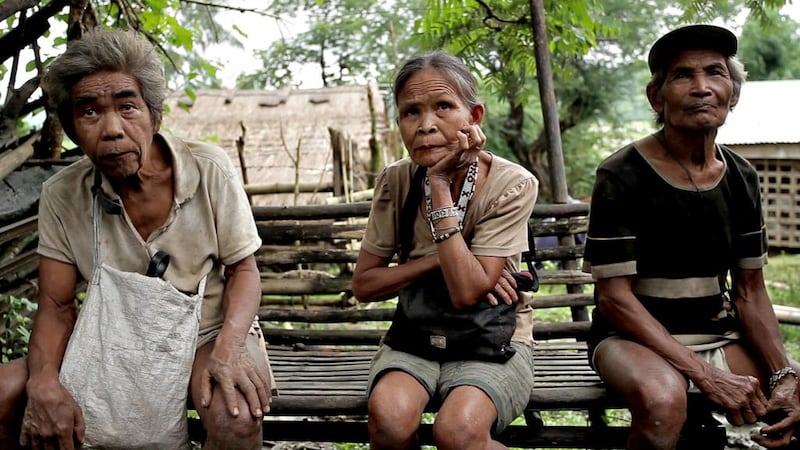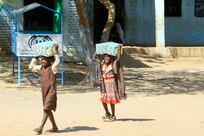Mindoro, Philippines // Deep in the jungle of a southern Philippine island, Fely Montajes, a member of the Buhid tribe, carves symbols on to a piece of bamboo, mouthing the sounds as she goes. She is inscribing a love poem in a practice that harks back to the days before these islands were colonised by the Spanish.
The script, known as Baybayin, is a collection of 17 cursive characters with similarities to the Brahmi texts of South India.
Ms Montajes is one of only a handful of people in the Philippines that still knows this ancient script, which dates back to 300BC, and is fighting to keep it alive.
Following Spanish colonisation in the 16th century, the inability of the script to record the new sounds used by the Europeans and the rapid introduction of Latin text spelt a death sentence for Baybayin. By the 18th century the alphabet was almost extinct.
One of the Philippines’ national heroes, Jose Rizal, who was executed by the Spanish in 1896, bemoans this loss of heritage to colonial rule in his poem To My Fellow Children saying: “This language of ours is like any other, it once had an alphabet and its own letters that vanished as though a tempest had set upon a boat on a lake in a time now long gone.”
However, in the jungles of the islands Mindoro and Palawan, three tribes living mostly in isolation – the Buhid, Hanunoo and Tagbanwa – managed to preserve the Baybayin script, each with their own variation.
In pre-colonial Philippines, these three groups lived along the coast of the ancient trade and migration routes between Borneo and Manila on the western flanks of Mindoro and Palawan. Upon the arrival of the Spanish, they were forced inland until they occupied only the highlands of the islands. By isolating themselves and refusing to sway to Spanish influence, they were able to preserve the alphabet.
Today, the script continues to face a battle against extinction. Only a few people in each community still know the letters and even fewer in tribal communities located closer to towns. In schools, the younger members are taught the Philippines main language, Tagalog, which they use to communicate with the city dwellers when trading.
The Baybayin script is now confined to writing poetry and love letters on pieces of bamboo or trees.
Ms Montajes, 40, is one of the few remaining tribal members that knows the Buhid version of the script in her community of Batuili on Mindoro.
“I inherited this from my parents. This is one of the few things that is still our own,” Ms Montajes says as she carves the letters.
“The basics of the script I learnt from my father. I realised that I was interested in it so I would write it by imitating him. The other letters I learnt from my friends,” she adds.
Maintaining these traditions is becoming increasingly difficult as tribes bend to the influences of the nearby city of San Jose or missionaries who visit the tribes.
“Right now it’s only the old kututubo [tribal members] who have their culture in tact. The new generation doesn’t seem to have,” says Bercelinda Babylya, 53, the captain of the Monte Claro district that includes 15 tribal communities.
“The ones that live far from the main community, up in the mountains, still kept their traditions in tact but for the ones who live closer to the city, we have already influenced them on how to dress etc.”
Even the older tribe members are losing knowledge of the script.
“It’s important for people to learn the script. No one teaches the kids anymore. We want someone to teach but there are few elders left,” says Say-ay Reyes, an 82-year-old tribal elder of the Buhid tribe at Batuili, where less than a third of the elders still have knowledge of the script.
According to Ms Babylya, the biggest challenge for the Buhid tribe now is surviving. Out of all her constituents, it is the tribal communities that struggle the most with basics such as food supplies. Education and literacy rates are also very low with only 10 per cent able to write.
More recently, there has been a nationwide effort in reviving the script as a symbol of national pride and identity.
“It’s part of the diverse Philippines culture,” says Emily Catapang, executive director of the Mangyan Heritage Centre. “The script, which was not really kept alive, is now being revived by individuals. Most of them are artists.”
The centre is trying to preserve this fast disappearing script and help the Mindoro tribes, known collectively as the Mangyan, safeguard and promote their culture, said Ms Catapang.
One of their primary projects is the preservation of the Mangyan syllabic script. They currently have teachers teaching the Hanunoo tribe’s version of the script in 10 schools in Mindoro.
“Until now the elders who know just the script just use it in signing their names when they have to sign legal documents,” says Ms Catapang. In some parts of the island the Baybayin script is used a few signs in the markets or in hospitals, she adds.
The Mangyan Heritage Center has a mobile unit and has travelled to over 70 different institutions, schools and colleges across the country to promote the cause. They also hold writing contests where participants take part in reading and writing traditional poetry in Baybayin.
Meanwhile back in Batuili, Ms Montajes continues to try and teach the script to anyone who’s willing to listen, but it’s a losing battle where the main priorities are how to farm enough to eat and live.
foreign.desk@thenational.ae





